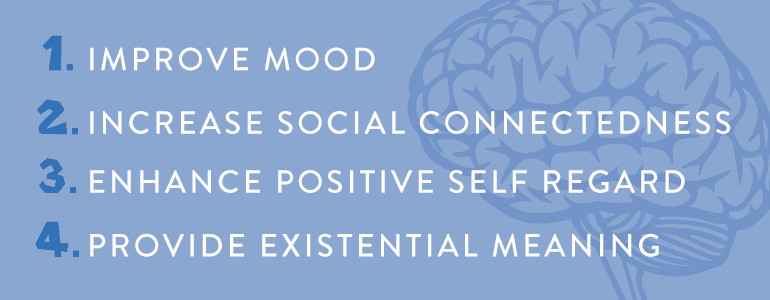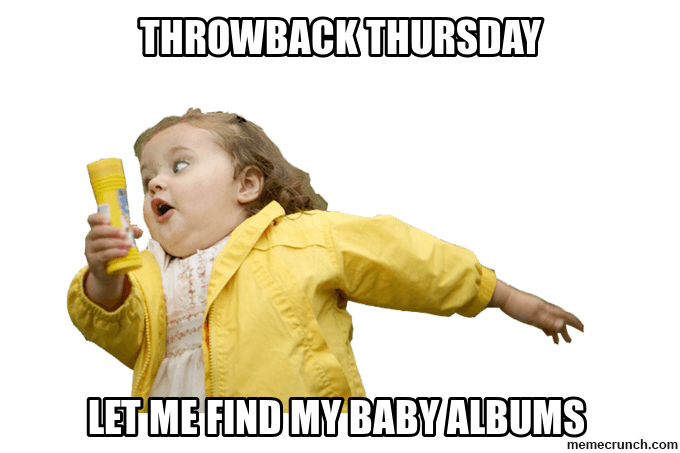Let 90s Nostalgia Rock Your Content Marketing
 New research shows that we are more likely to spend money when we're feeling nostalgic. According to the Journal of Consumer Research:
New research shows that we are more likely to spend money when we're feeling nostalgic. According to the Journal of Consumer Research:
Consumers that were asked to think about the past were willing to pay more for a set of products than consumers asked to think about new or future memories.Did that get your attention? Interesting results, but that's not all.
Another study showed an increased willingness to give more money to others after recalling, reflecting, or writing about a nostalgic past life event.This got me thinking – how does this "nostalgia effect" influence your content marketing? Are readers more likely to share your content when they are feeling nostalgic? Will they be more likely to convert? Will they be more likely to buy your product or service? The evidence seems to indicate that they might. The first step to applying this to your content marketing is to understand what nostalgia is in the first place.

What Is Nostalgia?
Technically, the term nostalgia describes a particular sentimentality towards a former experience. In simpler terms, it is a positive reflection of the past, and a powerful one at that. Nostalgia is generally triggered by some sort of cue from the past. This sentimentality is then associated with a period or place with happy personal memories. The term itself was coined by a 17th-century medical student as a way to describe the anxieties displayed by Swiss mercenaries fighting away from home. In later years, as science has learned more about the phenomena, nostalgia has been widely considered an independent and even positive emotion that people experience often. There are four commonly understood functions of nostalgia. They include, improve mood, increase social connectedness, enhance positive self-regard, and provide existential meaning. This is where things really start to get interesting for marketers.
Improve Mood
Nostalgia has often been found to increase one’s mood and heighten positive emotions. This reaction seems to stem from feelings of warmth or coping resulting from nostalgic reflections. In essence, the presence of nostalgic emotions give us a method for coping with things that could hinder our own happiness. This natural coping method instinctively seems to improve our mood and function.
Increase Social Connectedness
Interestingly, nostalgia also seems to increase our sense of social connectedness. This is a very important factor for the use of nostalgia in modern marketing. In essence, nostalgia is triggered by a feeling of loneliness, but counteracts such feelings with reflections of close relationships.
Enhance Positive Self-Regard
Nostalgia can also help us feel better about ourselves. Researchers found that subjects who thought of nostalgic memories showed more positive characteristics than those who thought of exciting future experiences. This research also revealed that a lack nostalgic experiences reflected a pattern of selfish and self-centered behavior. As nostalgic experiences were introduced, so was the positive behavior.
Provide Existential Meaning
You may be surprised to learn that nostalgia also helps increase one’s self-esteem and meaning in life. It does this by "removing" threats to our well-being, and also by initiating a desire to deal with problems or stress. Studies have found that nostalgia correlates positively with one’s sense of meaning in life.
Nostalgia is a known way to boost people's mood. It allows people to live (and re-live) something familiar, something they remember, a positive emotional experience. – Gabriel Trionfi (Pinterest's user experience researcher)
Examples Of Nostalgia In Internet Marketing
One of the best examples of nostalgia in internet culture is the popular photo-sharing service Instagram. These user-shared photos are soaked in nostalgia. Reminiscent of photos from old Polaroid cameras, the photos are frequently wrapped in a white border. In addition, by allowing users to select from a variety of filters (including some with labels like '1970'), users are able to re-create the faded and worn appearance that is recognizable from photos of the past. Instagram fosters a huge sense of nostalgia.
Blogger David Yoon calls this "fake nostalgia," and he certainly has a point – it is manufactured. But Instagram's features still do a great job of highlighting the power of nostalgia. In his piece, David points out that our digital photographs have lost the nostalgic "feel" because they did not age like more traditional photographs. This is a good point, and it helps us understand the rise in popularity of tools like Instagram.
While Instagram's nostalgia is purely manufactured, it is a harkening back to the "good old days of photography" and obviously brings with it some powerful emotions. We have to wonder: would Instagram have been as popular without the throwback?
We'll never know, but the theory is certainly worth considering.
Instagram fosters a huge sense of nostalgia.
Blogger David Yoon calls this "fake nostalgia," and he certainly has a point – it is manufactured. But Instagram's features still do a great job of highlighting the power of nostalgia. In his piece, David points out that our digital photographs have lost the nostalgic "feel" because they did not age like more traditional photographs. This is a good point, and it helps us understand the rise in popularity of tools like Instagram.
While Instagram's nostalgia is purely manufactured, it is a harkening back to the "good old days of photography" and obviously brings with it some powerful emotions. We have to wonder: would Instagram have been as popular without the throwback?
We'll never know, but the theory is certainly worth considering.
How To Take Advantage of Nostalgia In Content Marketing
Before we get too far, we need to set some ground rules. The folks over at Scripted have cleverly identified three conditions that should be met before we try to use nostalgia in our content marketing. They are:
- We must consider our target market’s age range in order to choose a time era that demographic can identify with.
- We have to choose an event, style, etc. that invokes positive memories and a sense of trust.
- The chosen era or event should invoke the emotions that we want people to associate with our brand.
Nostalgia only works in #contentmarketing if your content is actually nostalgic for your readers.
Click To Tweet5 Ways To Apply Nostalgia To Our Content Marketing
So you may be thinking that this nostalgia thing sounds great, but I haven't really provided any conclusive methods for introducing it to your content marketing. I am glad you brought it up. While this is by no means a conclusive list, here are 5 quick ideas that I've found for applying nostalgia to content marketing.#1: Weave Nostalgic References Into Your Content Through Storytelling
One of the easiest ways to incorporate the effects of nostalgia is through the art of storytelling and reference. Our own CoSchedule content creator, Julie Neidlinger, wrote a post a few years back bringing together the art of content marketing and the beloved mix tape of the 80s. In this type of post, the nostalgic reference is merely an element used to engage the reader in the work. It is simple and effective.#2: Add Nostalgic Reminders To Your Visual Elements
In many cases, nostalgic elements can be incorporated into the design of page elements, like they were on this post about audience fragmentation from just a few weeks ago. The visual elements on the page harken to a time and idea past, reflecting and fostering a feeling of nostalgia.#3: Interact With Your Audience In A Nostalgic Way
Whenever someone becomes a new paying customer of CoSchedule, we love to thank them with a physical notebook that they can use to jot down blog ideas when they are on the go. CoSchedule is a digital product so this is somewhat counterintuitive, but it has proven to be a great program. It encourages us and our users to think about the 'days of old' when we used to write thing in places other than the computer.#4: Create Content That Allows Readers To Experience Greater Nostalgia
Love them or hate them, Buzzfeed has garnered a great deal of attention by actually allowing us to interact with their own sense of nostalgia. On their site, you will find dozens of (basically meaningless) quizzes that allow us to discover which 90s soundtrack we are, or which "Friends" character we should hide in our basement. These may be silly, but they are also popular and are shared like crazy on Facebook.“The quiz is kind of like the broken-down-to-its-core of what BuzzFeed is,” Summer Anne Burton, Buzzfeed’s managing editorial director and the head of its quiz initiative, told Nieman Lab. “It gives someone something that they can relate to well enough that they can share it with others.” Buzzfeed built a custom template so that its staffers and its community contributors can easily create these identity-focused questionnaires. (source: The Atlantic)
#5: Throwback For A day
Microsoft has done an excellent job of using throwback nostalgia to improve its brand and reputation. After taking a beating for years with an error-ridden browser, their marketing team began using nostalgia (ironically) to make amends with the web developers that they have offended along the way – even going as far as releasing a throwback version of their website, an idea that will never get old for a generation of web developers who grew up using tables and font tags on this new thing called the "world wide web."The Effects Of Nostalgia In Content Marketing
Perhaps Don Draper said it best. Nostalgia is powerful, but delicate. Used correctly, though, it can help us accomplish many things – including better content marketing.Teddy told me that in Greek nostalgia literally means, the pain from an old wound. Its a twinge, in your heart. Far more powerful then memory alone. This device isn't a spaceship, its a time machine. It goes backwards, forwards. It takes us to a place, where we ache to go again. It's not called 'The Wheel.' It's called 'The Carousel.' It lets us travel in a way a child travels. Round and round, and then back home again. To a place where we know we are loved. - Don Draper
Nostalgia can make users more likely to share. #ContentMarketing
Click To TweetNostalgia can make users more likely to convert. #ContentMarketing
Click To TweetNostalgia can increase your traffic. #ContentMarketing
Click To Tweet--
There are unlimited ways to implement this idea into your marketing, and you will probably begin to see its effects everywhere. Learning to use it wisely and well can be a great asset to any content marketing strategy under the sun.


